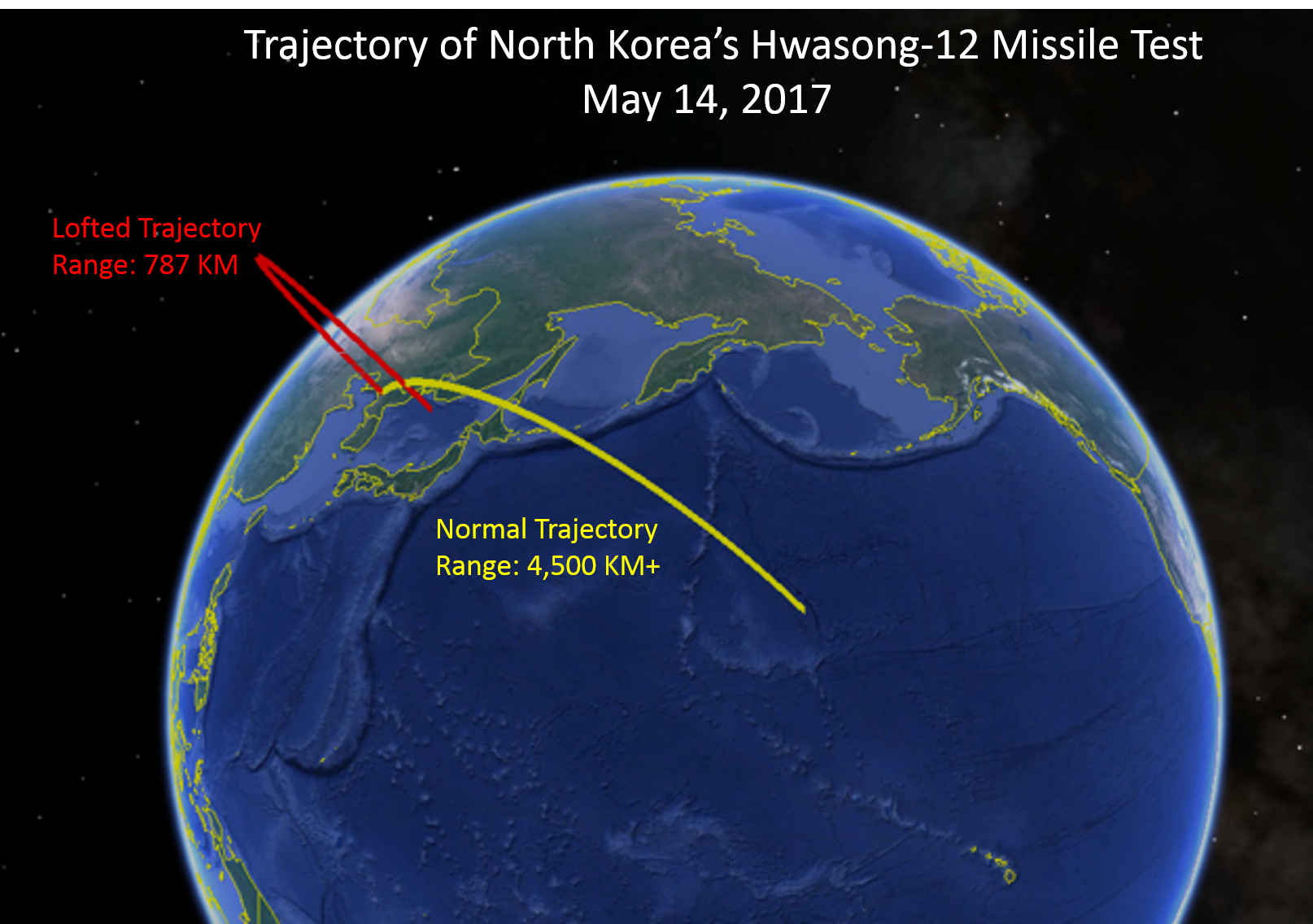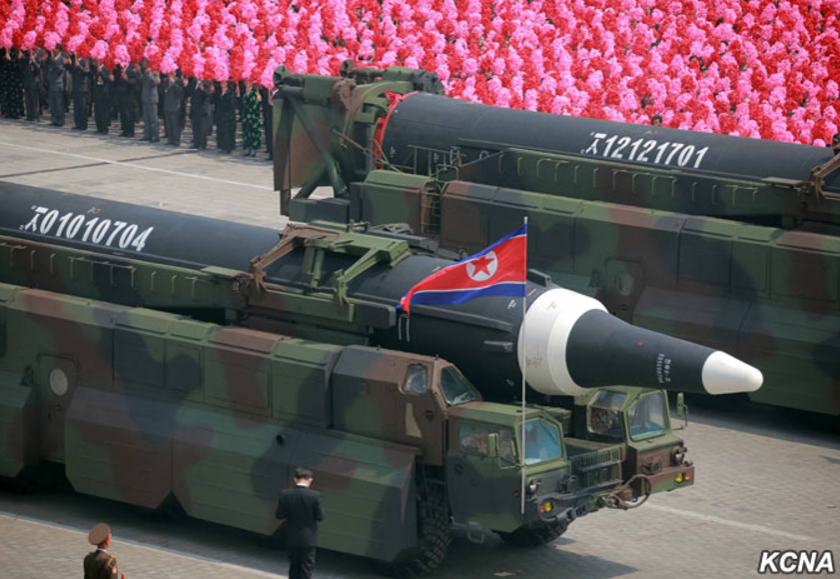
Jeffrey Lewis
Director of the East Asia Nonproliferation Program, The James Martin Center for Nonproliferation Studies
On May 12th, a high school model rocket team from North Carolina visited President Donald Trump in the Oval Office. The students were visiting Washington to participate in an annual model rocketry competition. The White House invited the students after learning one of the teams had named its tiny rocket “Trump” because, as one student told the President, “it conquers all.” [2]
At the same time in North Korea, dawn was breaking on the next day. A very different sort of rocket team was preparing for its big launch. Over the course of May 13th, North Korea’s supreme leader Kim Jong Un arrived at a large warehouse near Kusong to inspect a new missile of much greater range than anything North Korea had ever launched before. Kim watched workers bolt a warhead to the missile, lift the missile onto a heavy vehicle with a crane and pump rocket propellants into the missile using hoses.
The missile sat overnight – demonstrating that North Korea has developed the sophisticated capability to fuel its missiles hours in advance of their launch. Kim returned during the early morning of May 14th, saluting the vehicle as it drove off into the darkness toward its intended launch site three kilometers away. Shortly after dawn that day, North Korea launched the rocket, known as the Hwasong-12.
Move your cursor over the icons to learn more about the locations in the image.
The Hwasong-12 was, by far, the longest range missile North Korea had ever tested to that point. It traveled 787 km downrange, but reached more than 2,000 kilometers in altitude. (About the distance from Boston to Miami.) North Korea had fired the rocket nearly straight up to avoid flying over Japan. Had North Korea fired the rocket on a normal trajectory to go as far as possible, the Hwasong-12 would have flown around 4500 km.
The Hwasong-12 was shrouded in mystery prior to its launch. North Korea publicly displayed it for the first time during its April 15th parade marking the anniversary of “Great Leader” Kim Il Sung’s birth. The new missile appeared on a vehicle that had previously carried another missile. Most experts, including those of us at the Center for Nonproliferation Studies (CNS), wondered whether it was a larger version of that missile, or perhaps a smaller version of another.
When North Korea tested the Hwasong-12 on May 14th, it became clear that this was an entirely new missile, with a new engine and improved design characteristics. The Hwasong-12 is not itself an intercontinental ballistic missile (ICBM), but it displayed all the technologies necessary to build a missile that can strike the United States. Its range is estimated to be about 4,500 km with a nuclear-weapon-sized payload (500 kg), falling short of the 5,500 km range that defines an ICBM. When North Korea tested an ICBM a few weeks later on July 4th, it used the same engine and underlying technologies first seen in the Hwasong-12. If we wish to understand North Korea’s ICBM program, we must start with the Hwasong-12.
The Hwasong-12 launch signaled that North Korea’s missile program has entered a new phase with far more capable missiles. After their successful test, the missile’s designers were invited back to Pyongyang, where they were feted as heroes. The North Carolina model rocket team did not fare as well, finishing 85 out of 100 teams, but the students took justifiable pride in their participation in a national competition. At CNS, we developed our own model rocket—a computer simulation based on North Korean photographs and videos of the missile, to help us better understand the Hwasong-12 and its follow-on ICBM.
Click the play button to learn more about the Hwasong-12 with this 3D model.
We at CNS used a number of open source techniques to assess the validity of our model. In order to estimate the thrust of the “March 18” engine, we measured how quickly it accelerated the 30-ton missile during the first 3.5 seconds of its flight. We then tracked how far the missile moved in each frame of a high resolution video released by North Korea. This led us to estimate that the new engine produces nearly 50 tons of thrust.
We also estimated the mass of the airframe by analyzing images of the crane lifting the empty missile airframe. We were able to identify the crane in the images as a hydraulic truck crane produced in Japan. Based on the manufacturer’s specifications, and the length and angle of the crane arm, we estimated that the crane was probably set up to lift about 3.1 tons. After subtracting the payload, hook, lifting beam and two North Koreans riding with the missile, we estimated the mass of the empty airframe at about 2.1 tons – similar to our initial estimate and comparable Chinese and Russian long-range missiles.
Move your cursor over the icons to learn more about the locations in the image.
We then used all of the parameters to “fly” the missile in a computer simulation. The result of the computer simulation agreed almost exactly with the trajectory of the missile on its May 14th launch. Had North Korea fired the missile to its full range, it likely would have traveled more the 4,500 km.
Our model allowed us to see how the Hwasong-12, while not an ICBM itself, demonstrated the important technological developments that resulted in North Korea’s first ICBM test a few weeks later. These developments include:
While the Hwasong-12 test fell short of the range necessary to be considered an ICBM, it demonstrated the technological breakthroughs that allowed North Korea a few weeks later to make good on its commitment to test a missile capable of delivering a nuclear weapon to the mainland of the United States.
Sources:
[1] A longer version of this piece containing the full reconstruction of the Hwasong-12 is forthcoming with several co-authors who contributed heavily to this analysis, including Shea Cotton, Michael Duitsman and David Schmerler at CNS, and David Wright at the Union of Concerned Scientists.
[2] Ann Doss Helms, “These Charlotte kids named their rocket Trump and went to DC. Guess who took notice?,” The Charlotte Observer, May 12, 2017, www.charlotteobserver.com.
Sign up for our newsletter to get the latest on nuclear and biological threats.
View interactive visuals, analysis, and data on ballistic missile and SLV launches by North Korea, Iran, India, and Pakistan.
North Korea has altered its missile testing patterns, launching missiles more frequently and from a variety of new locations. What does this mean? (CNS)
North Korea’s nuclear weapons program deployed a nuclear-armed force of ballistic missiles. A 3D model of the test site suggests more may be on the way. (CNS)



